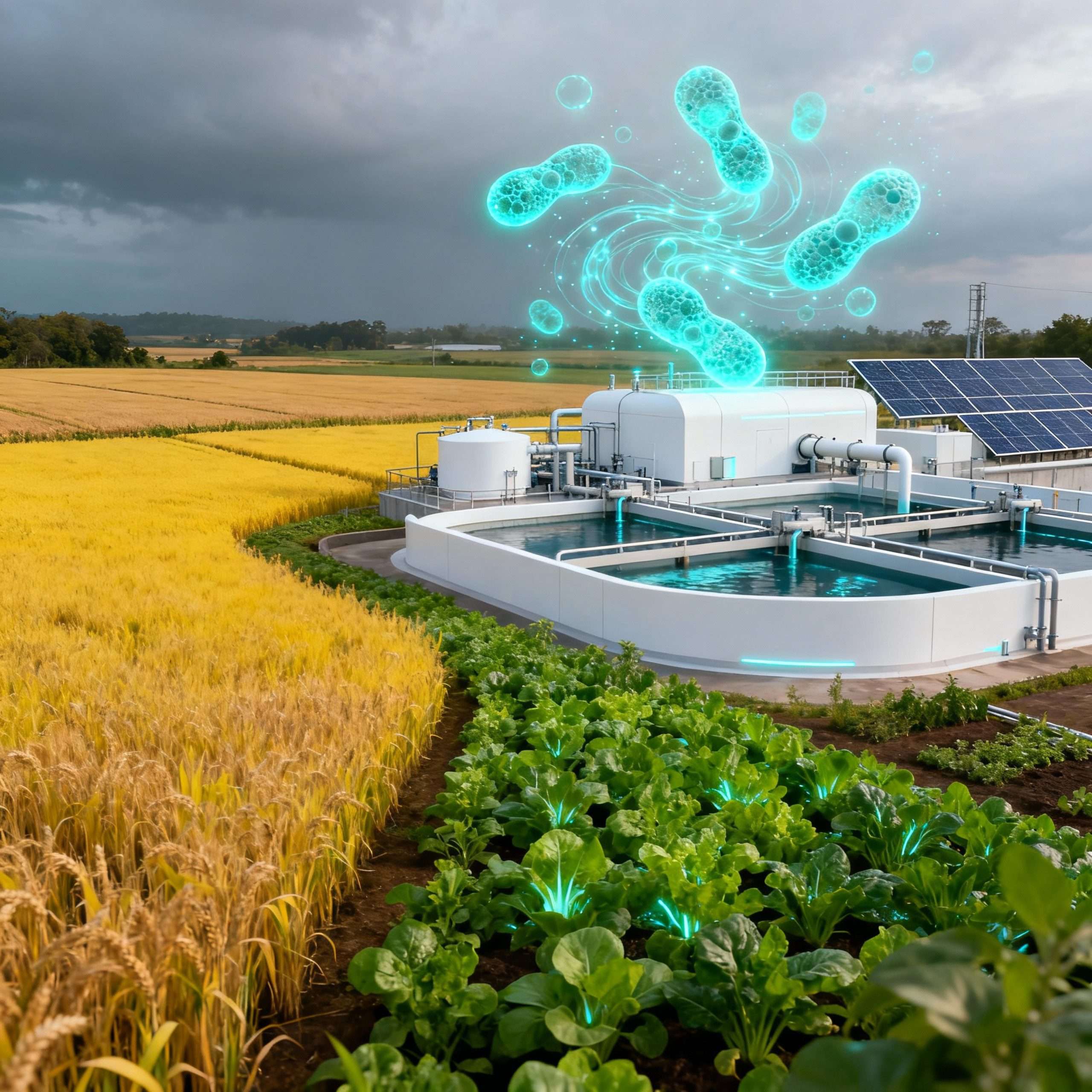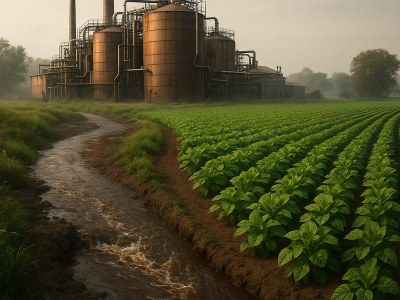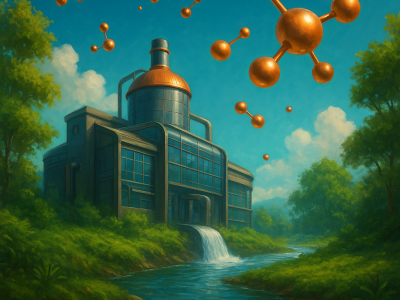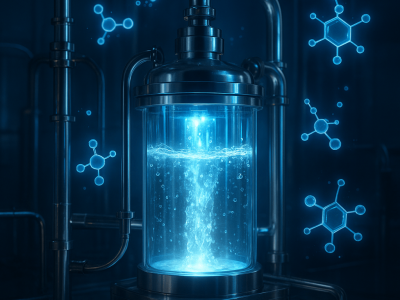Across India’s semi-urban landscapes, farmers are witnessing a silent crisis. Fields that once yielded plentiful harvests are now plagued by stunted crops and unhealthy plants. Leaves turn yellow and fall too soon. Yields shrink with each passing season. For many farmers, the cause of this devastation is invisible and elusive. The culprit is not drought or pests but contaminated water flowing from nearby oil refineries.
This reality was the focus of recent research led by Dr Izharul Haq, an environmental microbiologist at Manipal University, Jaipur. Published in the Archives of Microbiology, the study examined the impact of petroleum refinery wastewater on crops and explored a promising nature-based solution. It revealed that conventional treatment methods fail to remove all toxins, but that bioremediation using a specific bacterium, Bacillus subtilis strain IH-1, offers a ray of hope.
The hidden crisis of wastewater contamination
Petroleum refineries are essential to modern economies, but they produce vast quantities of wastewater loaded with complex organic compounds. These effluents contain phenols, polycyclic aromatic hydrocarbons (PAHs), oil residues, and suspended solids. Even after passing through conventional biological treatment plants, the wastewater often retains harmful levels of toxins.
In India, untreated or partially treated wastewater frequently seeps into farmland irrigation systems. Farmers, unaware of the invisible danger, use the contaminated water to grow staple crops. Over time, the pollutants disrupt plant physiology, causing a condition known as phytotoxicity. This manifests as reduced germination, impaired growth, and cellular damage that undermines nutrient uptake.
The research team highlighted how Central Pollution Control Board (CPCB) standards regulate permissible limits for phenols, sulfides, oils, and other compounds in wastewater. Yet in practice, refinery discharges often exceed these thresholds. The accumulation of pollutants does not only harm crops but also contaminates soils and nearby rivers, creating long-term risks for ecosystems and human health.
Why conventional treatment falls short
Industrial wastewater treatment usually relies on biological processes such as activated sludge systems or aerated lagoons. These methods are designed to degrade organic matter and reduce chemical oxygen demand. However, Dr Haq’s research demonstrated that such systems cannot effectively neutralise persistent organic pollutants.
Compounds such as naphthalene and phenanthrene are especially resilient. Their hydrophobic nature makes them difficult to degrade, allowing them to bind to soil particles and accumulate in sediments. These pollutants are cytotoxic, interfering with essential cell functions. In plants, they inhibit cell division, shorten root growth, and impair photosynthesis.
This finding underscores a broader truth in environmental science: conventional technologies may reduce visible pollution but cannot eliminate the invisible chemical threats that persist in ecosystems. To address this, innovative approaches are urgently required.
Microbial cleanup: Letting bacteria do the heavy lifting
Among the most promising solutions is bioremediation, which uses living microorganisms to detoxify polluted environments. Instead of adding chemicals or relying solely on mechanical processes, scientists harness bacteria and fungi capable of breaking down complex contaminants into simpler, less harmful compounds.
Dr Haq’s study focused on Bacillus subtilis strain IH-1, isolated from petroleum-contaminated sludge. This bacterium produces enzymes that metabolise hydrocarbons, including notoriously toxic PAHs. In laboratory conditions, Bacillus subtilis significantly reduced concentrations of naphthalene and phenanthrene in refinery wastewater.
The practical implications of this microbial activity were striking. When seeds of onions and mung beans were germinated in treated wastewater, they exhibited faster sprouting, longer roots, and healthier shoots compared with those exposed to untreated samples. This demonstrated that bioremediation is not just a theoretical concept but a viable pathway to revitalise contaminated water for agricultural use.
Persistent pollutants and their health risks
Despite the promise of microbial cleanup, the research also revealed ongoing challenges. Certain pollutants, known as persistent organic pollutants (POPs), and heavy metals such as cadmium or lead, resist microbial degradation. These substances linger in soils and aquifers for years, bioaccumulating in food chains and entering human bodies through crops and drinking water.
The health consequences are severe. Exposure to POPs is linked to genetic mutations, hormonal disruption, and increased cancer risk. Heavy metals can damage the nervous system and impair organ function. For communities living near refinery clusters, these pollutants represent an insidious threat that is difficult to detect but impossible to ignore.
The study, therefore, calls for a dual strategy. While microbial solutions can substantially reduce toxicity, stricter regulatory monitoring and innovative remediation technologies must complement them to ensure safety.
From local case study to global concern
Although the study focused on refinery areas in India, the findings resonate far beyond South Asia. Similar patterns of industrial contamination occur in oil-producing regions across Africa, South America, and parts of the Middle East. The research is therefore not merely a local case study but a contribution to a global dialogue on sustainable wastewater management.
Food security is one of the most pressing global challenges. If agricultural lands continue to be irrigated with polluted water, the consequences will reverberate across markets, public health systems, and international supply chains. Addressing refinery wastewater pollution is thus not only an environmental necessity but also an economic and geopolitical priority.
Regulation, enforcement, and innovation
India’s environmental framework has regulations in place, but enforcement often lags behind industrial growth. The CPCB provides strict numerical limits for effluents, yet monitoring and penalties remain inconsistent. Bridging this gap requires investment in monitoring infrastructure, stronger enforcement, and community involvement.
At the same time, industries must be encouraged to adopt sustainable technologies. Microbial treatments such as Bacillus subtilis offer a cost-effective supplement to existing wastewater treatment plants. When integrated with other methods such as constructed wetlands or advanced oxidation processes, they can form a comprehensive system capable of addressing multiple pollutants.
Public awareness campaigns are also crucial. Farmers, local residents, and civic organisations should be informed about the dangers of untreated wastewater and empowered to demand accountability. Environmental literacy is an underappreciated but vital tool in achieving long-term change.
Investing in microbial solutions for environmental protection is investing in a sustainable future, where nature and technology work hand in hand to restore balance.
– Dr. Izharul Haq
Looking ahead
The path forward is complex but hopeful. Petroleum refinery wastewater remains a formidable challenge, but bioremediation represents a turning point. The work of Dr Izharul Haq and colleagues demonstrates that even in the face of persistent pollutants, science offers solutions grounded in ecology rather than exploitation.
If policymakers, industries, and communities act together, the tools of microbiology could help restore farmland, secure food supplies, and protect public health. The alternative is continued degradation of soils, water, and livelihoods.
The question is not whether we can afford to adopt such innovations, but whether we can afford not to.
References
Haq, I., Kalamdhad, A. S., & Malik, A. (2024). Bioremediation of petroleum refinery wastewater using Bacillus subtilis IH-1 and assessment of its toxicity. Archives of Microbiology, 206(7), 296. https://doi.org/10.1007/s00203-024-04027-y







